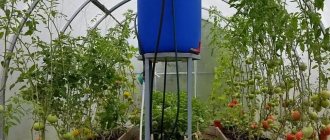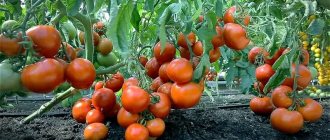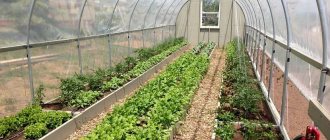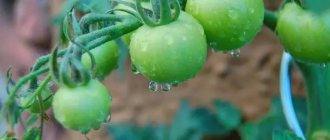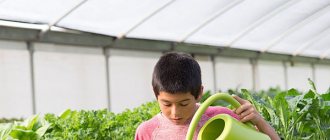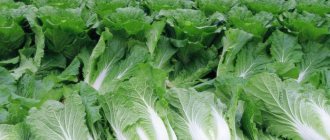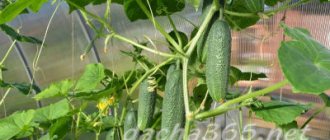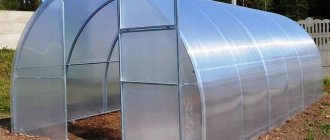Amateur gardeners and rural residents who grow vegetables for sale strive to obtain maximum yields with minimal costs. This can be achieved by using proven seeds, fertilizers and automatic watering in the greenhouse. The automation procedure includes calculating the system, purchasing hoses, controllers, filters and connecting them into a single system.
Greenhouse with drip irrigation Source butimex.com.pl
Benefits of Automation
Anyone who has experience in gardening knows that in the summer you should not rely on the weather, but you need to worry in advance that watering in the greenhouse and in the garden is regular and sufficient.
If it is possible to use water from a water supply, a well or a nearby body of water, you must immediately take care of an automatic watering system for the greenhouse when installing and arranging warm beds. These costs will subsequently be repaid many times over due to the increased harvest. Automated care is:
- systematic watering, independent of the presence of the gardener, his employment, well-being and capabilities;
- reduction in time costs, since you will only need to take part in system maintenance, cleaning, replacing damaged areas and other work that can be done at a convenient time;
- respect for the site, since when watering without human intervention, the beds are not trampled, the plants are not damaged by the moving hose;
- the ability to organize optimal automatic watering in the greenhouse taking into account the needs of the plants, for example, tomatoes and cucumbers require different amounts of moisture in the soil, air and frequency of irrigation.
A small greenhouse on a personal plot Source gardenportal.pl
Many people are put off by the size of the initial investment, but you can first try it in a small greenhouse in which the plants that need water most are grown. Once convinced of the convenience and effectiveness of the technology, they move on to distributing it to the entire site.
Rain
Through sprinklers, water falls onto the soil in the form of raindrops. The nozzles can be installed at ground level or mounted under the ceiling of the greenhouse.
The main advantage is the large coverage area and the creation of an optimal microclimate. The penetration of moisture to the optimal depth activates the vital activity of microorganisms.
Incorrect settings will contribute to over-humidification of the air in the greenhouse. During periods of high solar activity, burns of delicate greenhouse crops are possible.
Types of automatic watering
The irrigation system for a greenhouse is arranged in various ways. The choice depends on the size of the area, the method of water supply, the crop being grown, the financial capabilities and desires of the owner of the site.
Various types of irrigation Source sadyrad.ru
Common irrigation systems:
- sprinkling;
- drip ground;
- underground;
- using plastic bottles.
The sprinkling method of irrigation is practiced when there is a sufficient amount of water supplied under good pressure. Quickly moisturizes the entire greenhouse and plant from roots to leaves. This method is more suitable for open areas or large agricultural greenhouses. In a small area, it is necessary to provide increased ventilation, since most plants develop diseases under the influence of excessive humidity.
Sprinkler irrigation Source maecoor.com
Drip irrigation is the most economical method, which uses a minimum amount of water. Requires proper calculation of hoses, feed speed, and planned placement of seedlings. If all the preparatory work is done correctly, then drip irrigation has the most effective effect on yield.
A more complex option is underground drip irrigation. Its advantage is that water is delivered directly to the roots, while the top soil layer remains dry. As a result, no loosening or mulching of the soil is required. But this layer is the most difficult to install; it requires care when digging the beds and controlling weeds so as not to damage the hoses. It is very difficult to control the watering level. The only way to know that the holes in the underground pipes are clogged is that the plants begin to wither due to lack of water.
The irrigation system in a greenhouse using plastic containers is semi-automatic, as it requires regular and fairly frequent filling of bottles with water. The main advantage of the method is its low cost and simplicity.
Automatic watering through bottles Source fishki.net
But beds with such devices very quickly begin to look sloppy, the holes become clogged with earth, and the bottles themselves become clogged with plant debris. To ensure sufficient access of water to the plants, it is necessary to regularly clean the holes. This method should not be used on clay soil, since even when the soil first gets wet, it reliably clogs the irrigation cracks.
Using plastic bottles suspended above ground level prevents the containers from becoming clogged with soil, but on hot days the water quickly heats up and evaporates. This results in wasted water and unnecessary efforts to fill bottles.
Subsoil
Pipes with holes for water supply are laid underground so that moisture flows directly to the roots of plants.
Well suited for capricious greenhouse crops. Promotes additional saturation of the soil with oxygen. Maintains constant humidity in the greenhouse atmosphere. Saves water.
Failure to comply with installation instructions may result in over-moistening or drying out of the soil. The process will require serious labor during installation.
Device and installation diagrams
System installation diagram Source homesantehnica.ru
See also: Catalog of companies that specialize in landscape and garden work, water supply and sewerage
Installing a system that will automatically water the greenhouse begins with planning and calculations. A sample work plan includes:
- measuring the area of the greenhouse;
- drawing up a layout (beds, paths, heating systems, location of containers with fertilizers, etc.);
- calculating the length of the main hoses after determining the size of the planting area, for which it is necessary to add up the length of all the beds and add the distance to the water container;
- calculation of the number of fittings, taking into account the fact that the average distance between them is 30 cm, but the figures may vary depending on the characteristics of the plantings (their size, the distance between the bushes and the need for moisture).
The calculation of the necessary equipment includes pumps, filters, automation, start connectors, distribution taps and valves, and other parts that will be required for installation of the system.
There are companies that specialize in the professional installation of auto irrigation systems for greenhouses; they take care of all the calculations, design and installation of equipment.
Main elements of an automatic system Source teplica-exp.ru
Before laying the hoses, prepare a place for them. If it is assumed that water will be supplied by gravity, then it is necessary to position the system with a slight slope in the direction from the water source. Additional taps or removable plugs are installed at the remote ends of the hoses, through which the remaining water is drained at the end of the season.
When laying underground, a trench is dug with a depth of 10 to 50 cm, taking into account the thickness of the soil layer and the level of plant roots.
If you purchase a ready-made drip irrigation system, then you can simply spread it on the soil and connect the individual parts. When using conventional watering hoses, holes are made in them for attaching drip tapes through start connectors. It is advisable to secure the laid out hoses and tapes with holders so that they do not move under the pressure of water or while caring for plants.
This is what a drip irrigation system looks like Source butimex.com
When marking, the hoses are cut with some margin so that they are not too stretched. The reserve depends on the length of the bed and can be from 30 cm to 1 meter.
The entire manufactured system is connected to a water source. Sprinkler irrigation can be carried out directly from the water supply. For drip irrigation, you will need a container installed at a certain elevation. The choice of height depends on the size and design of the tank itself. It is necessary to find a level at which it is convenient to refill it. Pumps are used to pump water.
Installing a water tank near irrigation Source tyt.by
Drip
Through perforated pipes, water is delivered directly to each plant.
This principle of organizing the irrigation system ensures water savings of up to 30%. There are no favorable conditions for weeds. Loosening the soil needs to be done much less frequently.
High demands on cleanliness. Lack of filters can lead to rapid clogging.
Types of hoses
The industry produces several types of irrigation hoses, which differ in their strength, flexibility, resistance to bending and price.
Typically, the selection criterion is a compromise between the characteristics of products and their price.
Hoses are divided into:
- intakes, which are mounted between the water source and the container;
- irrigation systems, through which water is supplied to the plants;
- tapes providing drip supply of liquid.
You need to make the right choice among such a variety of hoses Source meme-arsenal.com
Types of automatic watering
Many plants require special care, so water delivery to the beds is organized in various ways.
- Subsoil watering method
- Drip irrigation
- Rain water supply
- Aerosol spray
Different methods differ not only in the method of watering, but also in the requirements for materials and installation.
Equipment for automatic systems
Automatic watering for a greenhouse is a costly undertaking at first. Therefore, almost every land owner tries to choose inexpensive but reliable equipment that can ensure stable operation of the system.
The main attention should be paid to the choice of automatic control systems, which use timers or controllers. Timers are simpler devices; they can be used to set the start and end times of watering during the day. You can set up several sessions during the day.
Equipment for automatic irrigation control Source allegroimg.com
Controllers can be single-channel or multi-channel. The former are used in small greenhouses, while the latter are capable of simultaneously serving several greenhouses or providing several irrigation modes. The controllers differ in that they have a display on which irrigation time, water consumption and other indicators are set
The most expensive models are equipped with GSM modules, which provide the ability to control the system remotely from a phone.
The second most important equipment is the pump. If the water is supplied from the water supply system, then you can do without it. But usually automatic systems provide an intermediate tank in which the water is heated to a temperature comfortable for the plants. In this case, a pump is needed to fill the tank. When choosing it, take into account:
- power (volume of water passed per unit of time);
- dimensions and weight that you need to know for fastening;
- type (submersible, surface);
- power supply method (electric, diesel);
- efficiency (consumption of electricity or other fuel required to fill containers).
The optimal model should cope with the given volumes of work and have a small additional power reserve.
Water filters Source allegroimg.com
Another mandatory addition is filters that are mounted between the container and the watering hoses. Their main task is to retain solid particles found in liquids so that they do not enter the system and clog the system. Typically, mesh filters are used that can be easily removed, cleaned and returned to their place.
When installing an irrigation system in a greenhouse, care must be taken to ventilate the room to ensure natural evaporation.
OGO-Rodnik-1
Photo: https://beru.ru/
This device measures soil moisture and turns on watering if necessary. In rainy weather, there will be no watering, and in dry weather, watering will be more frequent, which allows you to use water sparingly and effectively water the plants. The advantage of this Russian development is its low price, ease of installation and operation. The OGO-Rodnik system has the ability to interface with most drip irrigation kits, sprinkling systems and home-made irrigation components sold on the market.
Automatic watering OGO-Rodnik-1
Advantages:
- constant soil monitoring
- economical water consumption
- battery operation
Flaws:
- not detected
Briefly about the main thing
Automatic watering in a greenhouse is a real and not too costly rationalization that allows you to free up time and hands for other work and establish systematic and rational care of plants, regardless of the health status, capabilities and employment of people.
Setting up automatic watering requires:
- site planning;
- calculations of the quantity and range of necessary equipment;
- installation of a plumbing system inside the greenhouse;
- installation of automation equipment.
But after completing the work, it is enough to connect the system and just monitor its condition.
GA-3199(Beetle)
Photo: https://beru.ru/
Automatic timer for irrigation, irrigation controller and, including timer for water supply GA-319 (Beetle). The pressure in the system is from 0.2 to 6 atm, this timer has a membrane valve, which cannot but please any summer resident. Powered by two AAA batteries. Connecting dimensions: inlet 3/4HP, outlet 3/4HP with quick click screw-on adapter (quick release for hose). The front panel is closed with a translucent threaded lid with a rubber gasket. Colors may vary from those shown.
automatic watering GA-3199 (Beetle)
Advantages:
- ease of use
- affordable price
- reliable fastenings
- practicality
Flaws:
- no batteries included
Signor Tomato
Photo: https://beru.ru/
New for 2022! Definitely deserves a place in our top of the best automatic watering systems. The Signor Tomato system with a timer is capable of watering plants with water up to 8 programs! It runs at the frequency you set for it. Water for a period not exceeding 2 hours. Using this kind of watering can significantly simplify the task of fertilizing and at the same time protecting your pets. In contrast to complex computer systems, the operation of Signor Tomato 8 programs is based on the use of 2 standard batteries. The turnkey automatic watering system is placed in two boxes. The device is easy to use and designed for self-installation.
Signor Tomato Drip Irrigation Set
Advantages:
- ease of use
- long service life
Flaws:
- high price
- short hose
